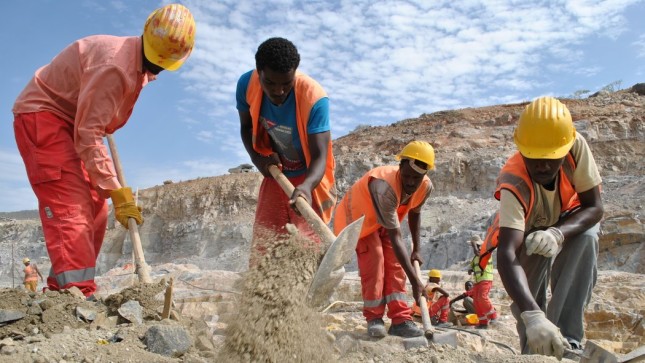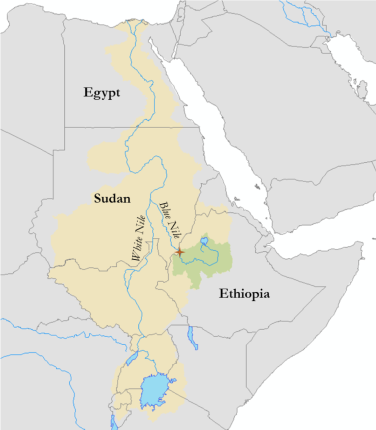-
Nile River Water Supply Forecasts May Reduce the Chance of Conflict
July 31, 2019 By Annalise Blum
Rising tensions between Egypt and Ethiopia over construction of the Grand Ethiopian Renaissance Dam (GERD) have led to speculation that there could be a war over water. When completed, the dam will be the largest in Africa. And it will give Ethiopia control over the Blue Nile River, a major source of Egypt’s water.
An agreement between Ethiopia, Egypt, and Sudan could reduce the chance of a conflict; however, discussions have reached a stalemate. Ethiopia would like to fill the reservoir in as few as three years to begin generating power and recover the costs of the dam. Already facing insufficient water supply, Egypt has called for the reservoir be filled slowly over at least seven and up to twelve years. Egypt is worried that rapidly filling the reservoir could reduce Nile flows by as much as 25 percent and devastate Egyptian farmlands. For Sudan, the dam will provide cheap electricity and reduce flow variability, benefiting farmers. Although it initially sided with Egypt against the dam, Sudan’s support shifted to Ethiopia in 2015.
Cooperative River Management
A common regional understanding of how much water is available is the first step toward cooperative management of the river. As described in our new paper, we developed a forecast to inform the conversation on filling the GERD reservoir. During the filling period, whether a given year is relatively wet or dry will be critical in determining downstream impacts.
A forecast-informed filling strategy could reduce the likelihood of harming downstream countries and, in providing an objective risk estimate, could facilitate cooperation between countries. However, water managers often hesitate to use forecasts due to uncertainty in predictions, concerns about the accuracy of the forecast, and/or a lack of understanding. Seasonal forecasting of multiple months in the future is particularly difficult and an area of ongoing research.
Additionally, forecasts from national meteorological agencies in the region could be perceived as biased. To provide a politically neutral outlook of likely Upper Blue Nile flows for each year during the filling period, we formed the ad hoc Blue Nile forecast group—a team of researchers working outside the region from Johns Hopkins University, University of Wisconsin-Madison, and University of California-Santa Barbara.

Forecasting Upper Blue Nile Water Supply
Most rainfall in the GERD basin falls during the months from June through September. The highest Blue Nile River flows follow the rains, lasting through December. A range of rainfall forecasts for the region are available including the Famine Early Warning System and the Greater Horn of Africa Climate Outlook Forum. Our forecast is different. Instead we forecast total Nile River flows for likely filling periods (June through December annually) at the GERD site specifically.
To generate forecasts of the probability of low, normal, and high flow scenarios, we use an ensemble of 16 models, including dynamic global climate models, published statistical models, and statistical models developed by our team. Years with substantial rainfall deficit, such as 2015, which was marked by drought, are frequently attributed to El Niño conditions. This relationship is often applied in seasonal meteorological forecasts in the region, but many sophisticated statistical models from the academic literature have never been applied. We wanted our forecast to be widely available as quickly as possible, so we published it on the Climate Hazards Center’s blog before the beginning of the summer rainy season in May 2018 and 2019.
In 2018, as we predicted, the Blue Nile flow was close to its long-term average, or about 40 billion m3 from June through December. As detailed in our forecast for 2019, this year is expected to be another relatively normal year for Upper Blue Nile flow. So far, that is proving to be the case.
Shifting Political Landscapes
Historically, tension over shared water bodies between countries have more often led to cooperation than conflict. Despite threatening talk by Egypt, the three countries have participated in sustained efforts at cooperation. Tripartite talks between Ethiopia, Egypt, and Sudan led the three countries to sign a Declaration of Principles agreement in 2015; however, little progress has been made since.
Further complicating matters is the fragile nature of these governments. In Ethiopia, Prime Minister Abiy Ahmed has already weathered assassination and coup attempts since taking office in 2018. With the downfall of President Omar al-Bashir in Sudan, a tripartite meeting originally scheduled for April was postponed. Some expect Egypt to use the Sudanese president’s downfall to sway Sudanese allegiance over the GERD back to Egypt. Additionally, the growing influence of Gulf countries, such as Saudi Arabia, the United Arab Emirates (UAE), and Qatar, could bring further instability to the region.
When Will Reservoir Filling Begin?
Originally, the dam was to be completed in 2017 but it is now slated for 2022. Construction has been plagued by allegations of corruption, defective equipment, and the mysterious death of the lead engineer last summer. Filling of the GERD reservoir can begin before the dam is completed. But it did not begin last year as anticipated.
Reservoir filling is expected to begin in 2020. However, it is too soon to know whether next year will be wet or dry. With any luck, it will be a wet year with plenty of flow to begin filling the GERD reservoir and supplying downstream water users. As there will almost certainly be a range of conditions during the filling period, forecasts can inform a common regional understanding of expected annual water availability, hopefully easing tensions and facilitating collaboration rather than conflict over the Nile.
Annalise Blum is a postdoctoral fellow at Johns Hopkins University and a visiting fellow with the American Meteorological Society’s Policy Program.
Sources: Addis Standard; Africa News; Agrlinks; Ahram Online; AP; BBC; Climate and Environment at Imperial; Climate Hazards Center; Development Aid; Environmental Change, Adaptation, and Security; Famine Early Warning System; Foreign Affairs; Foreign Brief; Frontiers in Water; Global Construction Review; Journal of Climate; Mada; National Oceanic and Atmospheric Administration; The New York Times.
Photo Credit: Men at work on the Grand Ethiopian Renaissance Dam project, October, 2014. Photo by Wikimedia Commons user Jacey Fortin.
Topics: Africa, conflict, cooperation, data, development, Egypt, energy, environment, Ethiopia, featured, Guest Contributor, hydropower, Infrastructure, security, Sudan, water
 A Publication of the Stimson Center.
A Publication of the Stimson Center.




